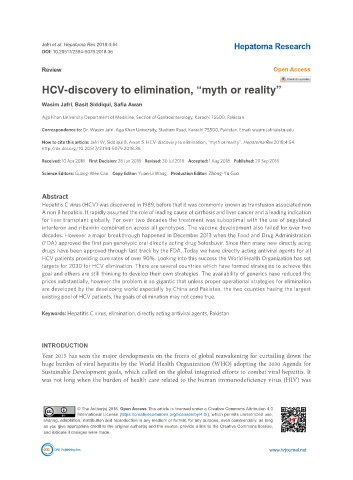Page 566 - Read Online
P. 566
Jafri et al. Hepatoma Res 2018;4:54 Hepatoma Research
DOI: 10.20517/2394-5079.2018.36
Review Open Access
HCV-discovery to elimination, “myth or reality”
Wasim Jafri, Basit Siddiqui, Safia Awan
Aga Khan University Department of Medicine, Section of Gastroenterology, Karachi 75500, Pakistan.
Correspondence to: Dr. Wasim Jafri. Aga Khan University, Stadium Road, Karachi 75500, Pakistan. Email: wasim.jafri@aku.edu
How to cite this article: Jafri W, Siddiqui B, Awan S. HCV-discovery to elimination, “myth or reality”. Hepatoma Res 2018;4:54.
http://dx.doi.org/10.20517/2394-5079.2018.36
Received: 10 Apr 2018 First Decision: 28 Jun 2018 Revised: 30 Jul 2018 Accepted: 1 Aug 2018 Published: 20 Sep 2018
Science Editors: Guang-Wen Cao Copy Editor: Yuan-Li Wang Production Editor: Zhong-Yu Guo
Abstract
Hepatitis C virus (HCV) was discovered in 1989, before that it was commonly known as transfusion associated non
A non B hepatitis. It rapidly assumed the role of leading cause of cirrhosis and liver cancer and a leading indication
for liver transplant globally. For over two decades the treatment was suboptimal with the use of pegylated
interferon and ribavirin combination across all genotypes. The vaccine development also failed for over two
decades. However a major breakthrough happened in December 2013 when the Food and Drug Administration
(FDA) approved the first pan genotypic oral directly acting drug Sofosbuvir. Since then many new directly acing
drugs have been approved through fast track by the FDA. Today we have directly acting antiviral agents for all
HCV patients providing cure rates of over 90%. Looking into this success the World Health Organization has set
targets for 2030 for HCV elimination. There are several countries which have formed strategies to achieve this
goal and others are still thinking to develop their own strategies. The availability of generics have reduced the
prices substantially, however the problem is so gigantic that unless proper operational strategies for elimination
are developed by the developing world especially by China and Pakistan, the two counties having the largest
existing pool of HCV patients, the goals of elimination may not come true.
Keywords: Hepatitis C virus, elimination, directly acting antiviral agents, Pakistan
INTRODUCTION
Year 2015 has seen the major developments on the fronts of global reawakening for curtailing down the
huge burden of viral hepatitis by the World Health Organization (WHO) adopting the 2030 Agenda for
Sustainable Development goals, which called on the global integrated efforts to combat viral hepatitis. It
was not long when the burden of health care related to the human immunodeficiency virus (HIV) was
© The Author(s) 2018. Open Access This article is licensed under a Creative Commons Attribution 4.0
International License (https://creativecommons.org/licenses/by/4.0/), which permits unrestricted use,
sharing, adaptation, distribution and reproduction in any medium or format, for any purpose, even commercially, as long
as you give appropriate credit to the original author(s) and the source, provide a link to the Creative Commons license,
and indicate if changes were made.
www.hrjournal.net

